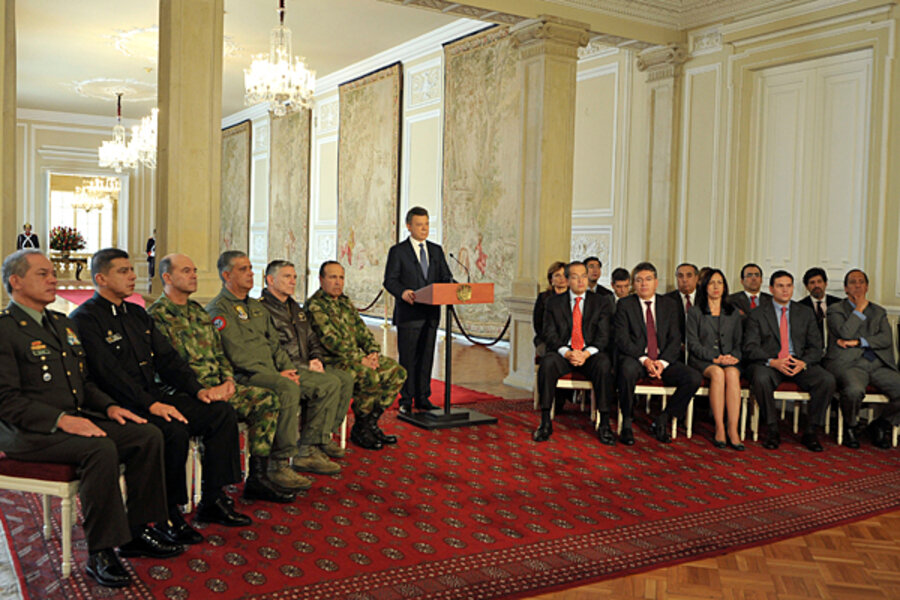Colombia to begin peace talks with the FARC, but no cease-fire
Loading...
| BOGOTA, Colombia
If Colombia hasn’t managed to negotiate an end to its internecine war, it’s not for a lack of trying.
On three separate occasions in the past 30 years the country’s largest guerrilla group and a succession of governments have sat down to peace talks, and failed. On Tuesday, President Juan Manuel Santos and Timoleón Jimenez, the top leader of the FARC guerrilla group, announced that the two sides would try again.
This time though, both men said, it’ll be different.
And while the president himself warned against exaggerated optimism, analysts say that never before have the chances been so high for peace talks to actually end in peace.
In a nationally televised address Mr. Santos revealed the five-point negotiating agenda that the two sides agreed to in preliminary talks. Those "exploratory" talks began at the start of the year in Havana and concluded Aug. 26 with an agreement to begin formal talks. Cuba and Norway are acting as “guarantors,” or facilitators, and Venezuela and Chile will act as witnesses.
Points of negotiation
"Any responsible leader knows he can't ... pass up a possibility like this to end the conflict," Santos said in a speech from the presidential palace yesterday, where he was flanked by his full cabinet and the military top brass.
The main points of discussion in the peace process – which will begin in Oslo in the first half of October and continue in Havana – include rural development, the recognition of victims, political participation, and the sticky issue of drug trafficking, the FARC’s main source of revenue.
The agenda also includes an issue that has never been included in previous talks: putting an end to the conflict.
“Never before had the FARC allowed the issue of them laying down their weapons to be placed on the agenda of peace talks,” says political analyst Leon Valencia, director of the Nuevo Arco Iris think tank and a former member of the smaller National Liberation Army (ELN) guerrilla group.
Shortly after Santos finished his announcement, FARC negotiators in Havana showed a video message from Mr. Jimenez, the FARC’s top-most leader who is better known as Timochenko. In the upbeat message, Timochenko declared that “The way out is not war but civilized dialogue.”
"We will not stand from the [negotiation] table until we have achieved our purpose,” he said.
For the first time, says Eric Farnsworth of the Council of the Americas, both sides appear to genuinely want peace. “Before, they weren’t aligned. When one party really wanted peace, the other was just playing along,” Mr. Farnsworth says. “Now all parties finally want peace.”
During the last round of negotiations from 1999 and 2002, both the FARC and government continued a major military buildup even while negotiators were talking about peace. The FARC recruited hundreds of new fighters and received explosives training, while the government began an antidrug and counter-guerrilla campaign known as Plan Colombia, funded with billions of dollars in US aid.
Today, the military is stronger and better equipped than ever, and the rebels, while crippled by a decade of sustained offensives against them, still have a significant capacity to stage attacks on both military and civilian targets.
'Possible new attacks'
However, the beginning of peace talks does not mean guns will immediately be silenced.
Santos said the two sides have agreed to negotiate without a cease-fire, a precondition that Santos had previously set for the start of talks. But reaching an agreement on a cease-fire before the official talks began may have meant they would never start, given the deep distrust between the two. Once a measure of trust builds between the negotiating parties, an end to hostilities would be a show of major progress. In the meantime, Santos told Colombians to brace for even more violence from the guerrillas while the talks go on.
“I ask the Colombian people to hold steady, to have patience and strength in the face of possible new attacks from the FARC or an increase in violence, which will be met with a resounding response by the security forces,” Santos said.
Negotiating while the bullets continue to fly is fraught with risks, not the least of which is the vehement opposition from critics of the government, such as former president Alvaro Uribe. The announcement of peace negotiations is “very serious because it means beginning a peace process without a halt to criminal activities by the terrorists,” Mr. Uribe told Caracol Television. “They kill Colombians and the talks will continue.”
On the other hand, the pressure of continued military action on both sides may be just what the process needs to move it forward. “This will put an immense pressure on the negotiators to reach an agreement on a bilateral cease-fire more quickly,” wrote Juanita León, editor of LaSillaVacia.com, a Colombian news website dedicated to political analysis.







